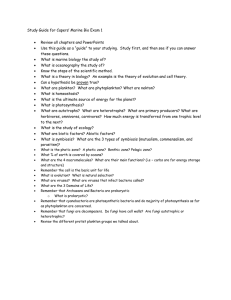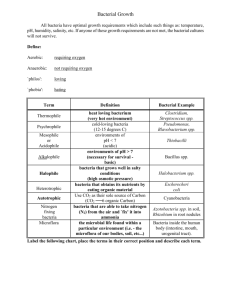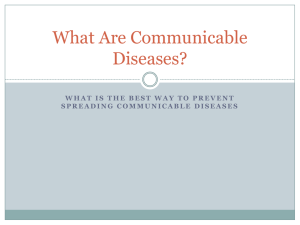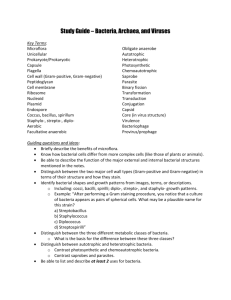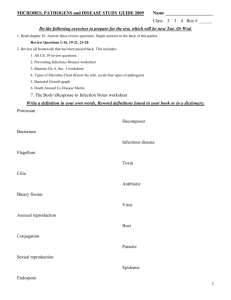Plant pathology
advertisement
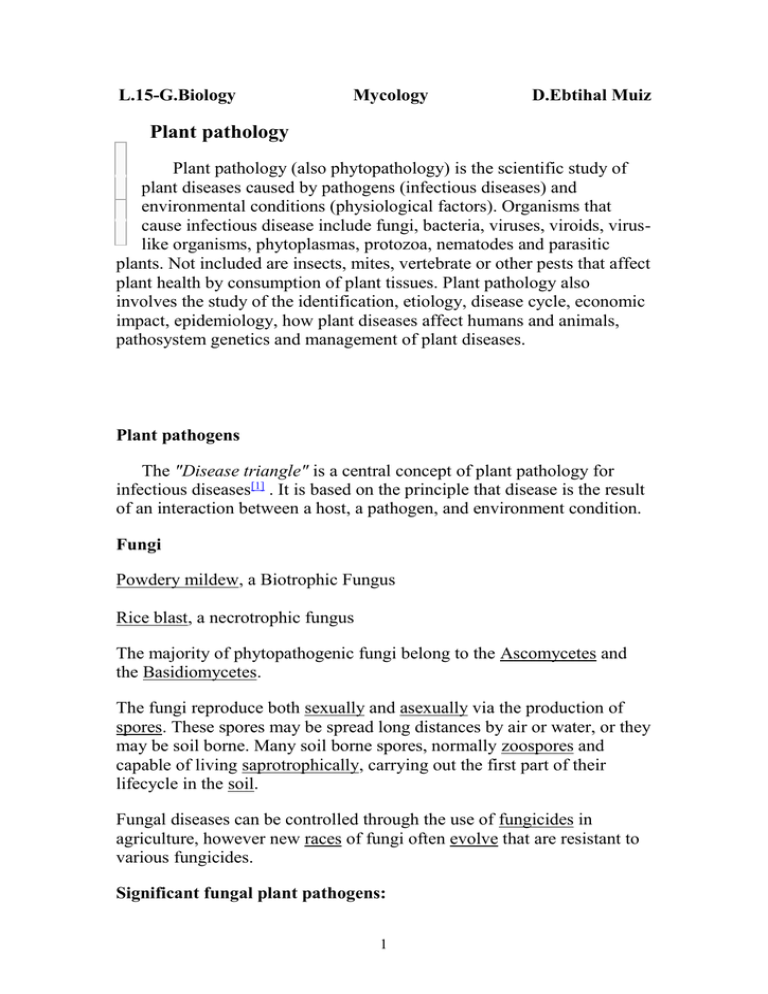
L.15-G.Biology
Mycology
D.Ebtihal Muiz
Plant pathology
Plant pathology (also phytopathology) is the scientific study of
plant diseases caused by pathogens (infectious diseases) and
environmental conditions (physiological factors). Organisms that
cause infectious disease include fungi, bacteria, viruses, viroids, viruslike organisms, phytoplasmas, protozoa, nematodes and parasitic
plants. Not included are insects, mites, vertebrate or other pests that affect
plant health by consumption of plant tissues. Plant pathology also
involves the study of the identification, etiology, disease cycle, economic
impact, epidemiology, how plant diseases affect humans and animals,
pathosystem genetics and management of plant diseases.
Plant pathogens
The "Disease triangle" is a central concept of plant pathology for
infectious diseases[1] . It is based on the principle that disease is the result
of an interaction between a host, a pathogen, and environment condition.
Fungi
Powdery mildew, a Biotrophic Fungus
Rice blast, a necrotrophic fungus
The majority of phytopathogenic fungi belong to the Ascomycetes and
the Basidiomycetes.
The fungi reproduce both sexually and asexually via the production of
spores. These spores may be spread long distances by air or water, or they
may be soil borne. Many soil borne spores, normally zoospores and
capable of living saprotrophically, carrying out the first part of their
lifecycle in the soil.
Fungal diseases can be controlled through the use of fungicides in
agriculture, however new races of fungi often evolve that are resistant to
various fungicides.
Significant fungal plant pathogens:
1
Ascomycetes
o
o
o
o
Fusarium spp.
Thielaviopsis spp. (Causal agents of: canker rot, black root
rot, Thielaviopsis root rot)
Verticillium spp.
Magnaporthe grisea (T.T. Hebert) M.E. Barr; causes blast of
rice and gray leaf spot in turfgrasses
Basidiomycetes
o
o
o
Rhizoctonia spp.
Phakospora pachyrhizi Sydow; causes Soybean rust
Puccinia spp.; causal agents of severe rusts of virtually all
cereal grains and cultivated grasses
Oomycetes
The oomycetes are fungal-like organisms that until recently used to
be mistaken for fungi. They include some of the most destructive plant
pathogens including the genus Phytophthora which includes the causal
agents of potato late blight and sudden oak death.
Despite not being closely related to the fungi, the oomycetes have
developed very similar infection strategies and so many plant pathologists
group them with fungal pathogens.
Significant oomycete plant pathogens
Pythium spp.
Phytophthora spp.; including the causal agent of the Great Irish
Famine (1845-1849)
Rice blast is hemibiotrophic
Bacteria
Crown gall disease caused by Agrobacterium
Most bacteria that are associated with plants are actually saprotrophic,
and do no harm to the plant itself. However, a small number, around 100
species, are able to cause disease.[2] Bacterial diseases are much more
prevalent in sub-tropical and tropical regions of the world.
2
Most plant pathogenic bacteria are rod shaped (bacilli). In order to be
able to colonise the plant they have specific pathogenicity factors. There
are 4 main bacterial pathogenicity factors:
1. Cell wall degrading enzymes - used to break down the plant cell wall
in order to release the nutrients inside. Used by pathogens such as
Erwinia to cause soft rot.
2. Toxins These can be non-host specific, and damage all plants, or host
specific and only cause damage on a host plant.
3. Phytohormones - for example Agrobacterium changes the level of
Auxin to cause tumours.
4. Exopolysaccharides - these are produced by bacteria and block xylem
vessels, often leading to the death of the plant.
Bacteria control the production of pathogenicity factors via quorum
sensing.
Significant bacterial plant pathogens
Burkholderia[3]
Proteobacteria
Xanthomonas spp.
o
Pseudomonas spp.
The Underlying Mechanisms of Bacterial Pathogenicity
Two broad qualities of pathogenic bacteria underlie the means by which
they cause disease:
1. Invasiveness is the ability to invade tissues. It encompasses
mechanisms for colonization (adherence and initial multiplication),
production of extracellular substances which facilitate invasion (invasins)
and ability to bypass or overcome host defense mechanisms.
2. Toxigenesis is the ability to produce toxins. Bacteria may produce two
types of toxins called exotoxins and endotoxins. Exotoxins are released
from bacterial cells and may act at tissue sites removed from the site of
bacterial growth. Endotoxins are cell-associated substance. (In a classic
sense, the term endotoxin refers to the lipopolysaccharide component of
the outer membrane of Gram-negative bacteria). However, endotoxins
3
may be released from growing bacterial cells and cells that are lysed as a
result of effective host defense (e.g. lysozyme) or the activities of certain
antibiotics (e.g. penicillins and cephalosporins). Hence, bacterial toxins,
both soluble and cell-associated, may be transported by blood and lymph
and cause cytotoxic effects at tissue sites remote from the original point
of invasion or growth. Some bacterial toxins may also act at the site of
colonization and play a role in invasion.
Phytoplasmas ('Mycoplasma-like organisms') and spiroplasmas
Main article: phytoplasma
Vitis vinifera with "Ca. Phytoplasma vitis" infection
Phytoplasma and Spiroplasma are a genre of bacteria that lack cell walls,
and are related to the mycoplasmas which are human pathogens. Together
they are referred to as the mollicutes. They also tend to have smaller
genomes than true bacteria. They are normally transmitted by sap-sucking
insects, being transferred into the plants phloem where it reproduces.
Viruses, viroids and virus-like organisms
Main article: Plant Virus
Pepper mild mottle virus
There are many types of plant virus, and some are even asymptomatic.
Normally plant viruses only cause a loss of yield. Therefore it is not
economically viable to try to control them, the exception being when they
infect perennial species, such as fruit trees.
Most plant viruses have small, single stranded RNA genomes. These
genomes may only encode 3 or 4 proteins: a replicase, a coat protein, a
movement protein to allow cell to cell movement and sometimes a
protein that allows transmission by a vector.
Plant viruses must be transmitted from plant to plant by a vector. This is
normally an insect, but some fungi, nematodes and protozoa have been
shown to be viral vectors.
4
Nematodes
Root-knot nematode galls
Nematodes are small, multicellular wormlike creatures. Many live freely
in the soil, but there are some species which parasitize plant roots. They
are mostly a problem in tropical and subtropical regions of the world,
where they may infect crops. Root knot nematodes have quite a large host
range, whereas cyst nematodes tend to only be able to infect a few
species. Nematodes are able to cause radical changes in root cells in order
to facilitate their lifestyle.
Protozoa
There are a few examples of plant diseases caused by
protozoa. They are transmitted as zoospores which are very
durable, and may be able to survive in a resting state in the soil
for many years. They have also been shown to transmit plant
viruses.
When the motile zoospores come into contact with a root hair
they produce a plasmodium and invade the roots.
Parasitic plants
Parasitic plants such as mistletoe and dodder are included in the study of
phytopathology. Dodder, for example, is used as a conduit for the
transmission of viruses or virus-like agents from a host plant to either a
plant that is not typically a host or for an agent that is not grafttransmissible.
Physiological plant disorders
Main article: Physiological plant disorders
Significant abiotic disorders can be caused by:
Natural
Drought
Frost damage, and breakage by snow and hail
Flooding and poor drainage
Nutrient deficiency
Salt deposition and other soluble mineral excesses (e.g. gypsum)
5
Wind (windburn, and breakage by hurricanes and tornadoes)
Lightning and wildfire (also often man-made)
Man-made (arguably not abiotic, but usually regarded as such)
Soil compaction
Pollution of air and/or soil
Salt from winter road salt application
Herbicide over-application
Poor education and training of people working with plants (e.g.
lawnmower damage to trees)
Vandalism
Management
Quarantine
Where in a diseased patch of vegetation or individual
plants are isolated from other, healthy growth. Specimens
may be destroyed or relocated into a greenhouse for
treatment/study. Another option is to avoid introduction of
harmful non-native organisms by controlling all human
traffic and activity (for e.g., AQIS) although legislation
and enforcement are key in order to ensure lasting
effectiveness.
Cultural
Farming in some societies is kept on a small scale, tended by
peoples whose culture includes farming traditions going back to
ancient times. (An example of such traditions would be lifelong
training in techniques of plot terracing, weather anticipation and
response, fertilization, grafting, seed care, and dedicated
gardening.) Plants that are intently monitored often benefit not only
from active external protection, but a greater overall vigor as well.
While primitive in the sense of being the most labor-intensive
solution by far, where practical or necessary it is more than
adequate.
Plant resistance
Sophisticated agricultural developments now allow growers to
choose from among systematically cross-bred species to ensure the
greatest hardiness in their crops, as suited for a particular region's
pathological profile. Breeding practices have been perfected over
6
centuries, but with the advent of genetic manipulation even finer
control of a crop's immunity traits is possible. (The engineering of
foodplants may be less rewarding however, as higher output is
frequently offset by popular suspicion and negative opinion about
this "tampering" with nature.
Chemical
(See: crop dusting) Many natural and synthetic compounds exist
that could be employed to combat the above threats. This method
works by directly eliminating disease-causing organisms or curbing
their spread; however it has been shown to have too broad an
effect, typically, to be good for the local ecosystem. From an
economic standpoint all but the simplest natural additives may
disqualify a product from "organic" status, potentially reducing the
value of the yield.
Biological
Crop rotation may be an effective means to prevent a parasitic
population from becoming well established, as an organism
affecting leaves would be starved when the leafy crop is replaced
by a tuberous type, etc. Other means to undermine parasites
without attacking them directly may exist.
Integrated
The use of two or more of these methods in combination offers a
higher chance of effectiveness.
Stages in the development of disease
A. Inoculation: coming together of host and parasite
o
Inoculum; any part of a parasite that can cause infection
o Sources of inoculum
Primary - initial
Secondary - produced from previous infection
o Steps in inoculation
arrival at site
germination of spores and seeds - hatching of vector,
if required
landing of insect, if required
attachment to host
7
recognition of host/parasite by parasite/host
B. Penetration
o Direct through intact plant surfaces
o Penetration through wounds
o Penetration through natural openings
C. Infection - parasitism
o recognition of the host by the parasite
o Pathogenesis may be latent in expression
o May require a incubation period
o Is an expression of the virulence on the pathogen
o Is an expression of the resistance of the host
o Is dependent on a dynamic and balanced interaction
D. Invasion - ramification
o Disease, in many cases, reflects the extent of ramification
or spread of the parasite/pathogen
o Most movement is intercellular.
o Generalizing, parasites can be grouped in to two types,
"thugs": parasites that are highly aggressive;
bludgeoning their way through host tissue with
batteries of enzymes and physical prowess.
Typically they extract their nutrients from leaking
and moribund host cells.
"con men" : parasites that depend on fitness. Though
they may be no less aggressive, their mode of
parasitism is usually to "con" the host into providing
for their needs.
E. Growth and reproduction
o Reproduction is the primary "concern" of any organism
o Reproduction may be sexual or asexual
o Does genetic recombination occur without sexual
reproduction?
F. Dissemination
o Air
o Water
o Vectors
o Plant materials
o Humans
G. Overwintering / Oversummering of Pathogen
8



